It’s incredible how a microscopic virus has created such rapid cultural change in such a short period. The public health orders for social distancing and shelter in place have resulted in the closure of fitness facilities and left many exercise enthusiasts scrambling to identify solutions for working out at home.
As of this writing, the hashtags #homeworkout and #workoutathome have 3.2 million and 1 million posts, respectively, but can a home workout replace the sessions at your favorite fitness facility? Yes, it is possible to get a good workout using just your bodyweight, but what about those of you who like to push yourself when you sweat?
The good news is that it is not that difficult or expensive to set up a home gym; all you need is a little space and some creativity. Whether you are a home gym specialist looking to help a client set up a home exercise space, or a fitness enthusiast interested in fitness from the comfort of your own home, this blog will offer home gym solutions.
These solutions with come with three budgets in mind: less than $75 (the approximate price of 3 studio workouts), $200 (the estimated cost of 4 months of a gym membership or one month of unlimited classes at a boutique studio) and an unlimited budget (in case Jeff Bezos or Mark Zuckerberg are reading).
For an Affordable yet reliable home gym: Budget = $75
- Mini-band - this piece of rubber resistance is very affordable, easy to store, and provides several excellent options for both the lower and upper body.
- 1 set of dumbbells - many of the large big-box retailers that sell groceries also sell fitness equipment, select a pair that makes 10-12 reps challenging.
- 2-arm resistance band - this band can easily be attached to a door frame and allows you to replicate several cable machine exercises while at home.
- Jump rope - budget-friendly, easy to store, and can make you sweat = win, win, and win.
For additional equipment recommendations, check out this podcast episode:
Best home gym for your buck? Budget = $75 - $200
In addition to all of the equipment in the $75 range, add these to your home gym to take it a step higher.
- Stability ball - you can do several bodyweight exercises to strengthen all of your muscles, especially those in the core region. These can be bought at many big-box retailers like Target and Walmart.
- A Sandbell by Hyperwear - the unique design is great for grip strength and is easier to store in a small space when compared to medicine balls.
- A kettlebell - again, many big-box retailers now sell kettlebells, which can be used for strength, power, or metabolic conditioning exercises.
If you have an Unlimited budget!
- TRX Suspension Trainer - the original, pick up the commercial version for a piece of long-lasting equipment.
- Another pair of heavier dumbbells and a 2nd, heavier kettlebell. Heck, if you can afford it, get a whole rack of dumbbells and three or four kettlebells to have the widest variety of training options.
- The Terra Core - this relatively new piece of equipment provides the benefits of a stability ball, the inflatable bladder is less pressure on the shoulders and back for exercises like the chest press, while having the stability of a bench.
- A HIIT Bike or Indoor rower - using both the upper and lower body at the same time can increase the number of calories you burn, search for companies that sell used commercial gym equipment. Yes, this could be more expensive, but it’s much better quality than what is sold via normal retail channels like sporting goods stores.
how to do cardio without a home gym
Missing your favorite cardio workout? You’re not alone! No, you do NOT need to invest in expensive equipment or a costly monthly subscription to get a lung-busting cardio workout in your own home.
Performing a Tabata protocol of high-intensity interval training (HIIT) using only bodyweight exercises is an excellent option that has demonstrated to be useful for improving aerobic conditioning.
Which would you rather do, run for 30 minutes on a treadmill or work REALLY HARD for only 4 minutes? Research suggests that three 4-minute Tabata sessions using only bodyweight exercises can be as, if not MORE, effective than three 30-minute workouts on a treadmill.
tabata workouts for home: They work better than a treadmill (Case Study)
In their recently published study, Schaun and colleagues organized participants into three separate training groups for the sixteen-week experiment. The fifty-five participants were healthy young men with an average age of 23 years-old who were organized into the three following groups:
- HIIT-T - 17, where participants performed a Tabata protocol on a treadmill by running at a velocity associated with 130% of VO2 Max for 20 seconds, followed by a 10-second rest, repeated for eight cycles for a total of 4 minutes.
- HIIT-WB - in this group, 19 participants did a Tabata interval workout using bodyweight movements, including Burpees, mountain climbers, jumping jacks, and squat thrusts with 3-kilogram kettlebells.
- MICT - this group contained 19 participants who ran on a treadmill for 30 thirty minutes at an intensity associated with 90% of their heart rate at the second ventilatory threshold (VT2).
The groups were each measured for the time to reach VT2 and the time to reach exhaustion at the beginning and end of the study.
After the completion of the 16-week study period, the testing showed that each group experienced an improvement in their fitness levels, and the group with the best results was the HIIT-T group. However, the HIIT-WB group showed a greater improvement than the MICT group with results that were not that much different than the HITT-T group.
Two primary outcomes from the study are that the Tabata protocol of HIIT can be a time-efficient workout solution and that performing a Tabata protocol with only bodyweight exercises can provide cardiorespiratory benefits when traditional gym equipment is not available.
This study strongly suggests that when the traditional gym is not accessible, a 4-minute Tabata workout becomes a solution that can produce results.
See also these blogs for better home workouts: HIIT Workouts | Tips for Working Out at Home
A Sample tabata workout for at home workouts
The circuit below is similar to the one used in the study with one minor change, the use of ice skaters (hopping from right to left on each leg as fast as possible like ice skating) instead of the squat thrusts with kettlebells.
Go to your app store and download a Tabata timer, press start on your favorite playlist, and have at it for this circuit. The good news is that if you move at your fastest rate possible, then you only need to do it one time!
- Burpees
- Mountain Climbers
- Ice skaters
As you can see, you don’t need to break the bank or have a large, unused room to have numerous options for staying in shape while sheltering in place.
Read also: The Benefits of Tabata Workouts
References
Schaun, G., Pinto, S., Silva, M., Dolinski, D., and Alberton, C. (2018) Whole-body High-Intensity Interval Training Induce Similar Cardiorespiratory Adaptations Compared with Traditional High-Intensity Interval Training and Moderate-Intensity Continuous Training in Healthy Men. Journal of Strength and Conditioning Research. 32(10). 2730-2742.
















